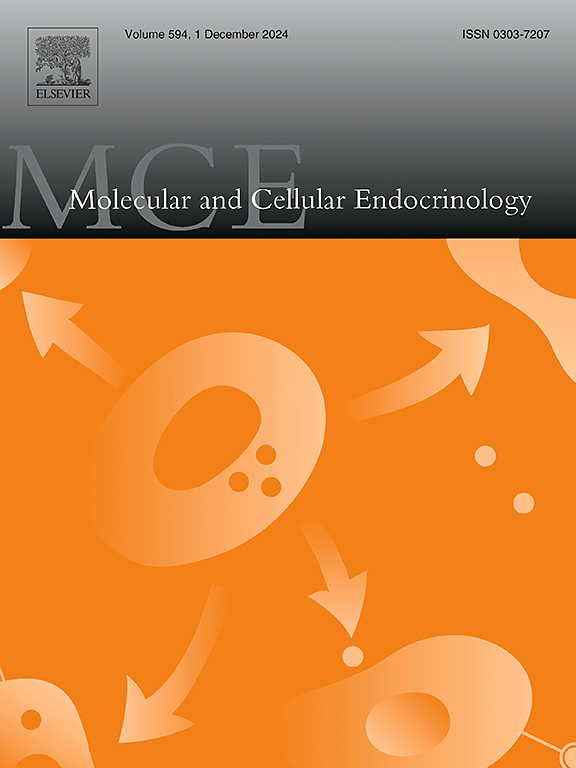多囊卵巢综合征:对生育和子宫病变的长期影响。
IF 3.6
3区 医学
Q2 CELL BIOLOGY
引用次数: 0
摘要
多囊卵巢综合征(PCOS)是育龄妇女常见的内分泌疾病。在这项研究中,我们旨在探讨多囊卵巢综合征的长期影响。我们在实验模型中评估了3月龄时的生育能力、6月龄和24月龄时的子宫组织形态学以及内分泌状况。采用皮下注射脱氢表雄酮(6 mg/100g bw)诱导21 ~ 40日龄雌性Wistar大鼠PCOS。治疗后,将大鼠分组,分别于妊娠第18天(GD18)、6个月和24个月时安乐死。对GD18进行生育试验,PCOS大鼠未见生育变化。6月龄时,PCOS大鼠出现子宫病变,并伴有血清17-β雌二醇(E2)/孕酮(P4)比值升高。24月龄时,PCOS大鼠腔内增生发生率较高,腺体化生较多,腺体聚集较多。这与血清E2/P4比值、子宫类固醇生成酶(类固醇硫酸酯酶、5α-还原酶I型)和雌激素受体α表达升高有关。此外,观察到子宫内嗜酸性粒细胞浸润增加,提示雌激素作用。这些结果表明,早期多囊卵巢综合征长期改变子宫内分泌状态,表明子宫对雌激素的暴露和敏感性增加。综上所述,这些发现可以解释PCOS组子宫病变发生率/多样性增加的原因。本文章由计算机程序翻译,如有差异,请以英文原文为准。
Polycystic ovary syndrome: Long-term effects on fertility and uterine lesions
Polycystic ovary syndrome (PCOS) is a common endocrine disorder in women of reproductive age. In this study, we aimed to investigate the long-term effects of PCOS. We assessed fertility at 3 months of age and uterine histomorphology along with endocrine status at 6 and 24 months of age in an experimental model. PCOS was induced in female Wistar rats from 21 to 40 days of age by subcutaneous injection of dehydroepiandrosterone (6 mg/100 g bw). After treatment, rats were separated into groups and euthanized on gestational day 18 (GD18), 6 months and 24 months of age. Fertility test was performed on GD18 and no changes were observed in the PCOS rats. At 6 months of age, PCOS rats showed uterine lesions associated with a higher serum 17-β estradiol (E2)/progesterone (P4) ratio. At 24 months of age, PCOS rats had a higher incidence of luminal hyperplasia and a greater number of glands with metaplasia and conglomerates of glands. This was associated with increased serum E2/P4 ratio, uterine steroidogenic enzymes (steroid sulfatase, 5α-reductase type I) and estrogen receptor alpha expression. In addition, an increased infiltration of eosinophils in the uterus was observed, suggesting an estrogenic effect. These results show that PCOS induced early in life alters the uterine endocrine status in the long term, suggesting increased uterine exposure and sensitivity to estrogens. Taken together, these findings may explain the increased incidence/multiplicity of uterine lesions observed in the PCOS group.
求助全文
通过发布文献求助,成功后即可免费获取论文全文。
去求助
来源期刊

Molecular and Cellular Endocrinology
医学-内分泌学与代谢
CiteScore
9.00
自引率
2.40%
发文量
174
审稿时长
42 days
期刊介绍:
Molecular and Cellular Endocrinology was established in 1974 to meet the demand for integrated publication on all aspects related to the genetic and biochemical effects, synthesis and secretions of extracellular signals (hormones, neurotransmitters, etc.) and to the understanding of cellular regulatory mechanisms involved in hormonal control.
 求助内容:
求助内容: 应助结果提醒方式:
应助结果提醒方式:


